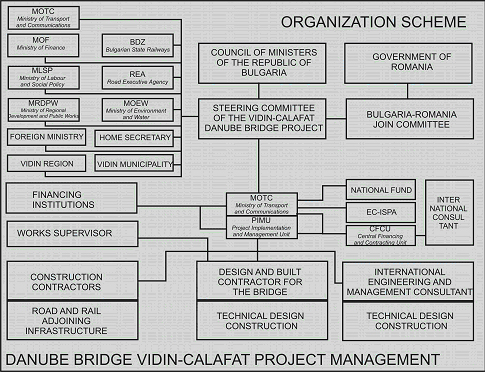 |
 |
 |
 |
 |
 |
 |
 |
 |
 |
 |
 |
Decision making process
Name der Fallstudie
Project for a New Bridge over The Danube (Vidin -Calafat)
Projekt Neue Brücke über die Donau (Vidin- Calafat)
Decision making process - stages
Actors involved in the decision-making process: Bulgarian Government (represented by Ministry of Transport and Communications and Ministry of Environment and Waters); Romanian Government; European strategic donors (AfD, ISPA, KfW, Phare), financial supporters (KfW, EIB), EIA report team, local business, citizens of Vidin and Calafat, environmental organizations and NGOs.
The decision-making process is outlined by the legislative framework for EIA implementation. Nevertheless the cooperation posed the necessity for a specific decision making scheme concerning the project development. It needed a unit to coordinate, organise and manage all life cycle processes. For that reason the Project Implementation and Management Unit (PIMU) was created and began functioning in Bulgarian Ministry of Transport and Communication in July 2000. Mainly experts in construction were involved in PIMU ? an expert engineer in railway sector (team leader), a bridge engineer, an engineer in construction, a railway engineer). Financial and legislation experts were also included; other experts were contracted for specific research or consultation.
Decision making process - levels
The decision making process follows an organization scheme generally divided into three main levels (see below):
? Political ? decisions made by both governments, ministries, municipalities and the steering committee concerning the development framework of the project;
? Financial ? decision about the project budget (Ministries of Finance);
? Planning ? decisions about the technical design construction, planning of the adjoining infrastructure and updating of the Master Plans of both towns (Vidin and Calafat).

Organisation scheme of the project implementation
Decision making process - sources of information
No information available
Decision making process - who are the decision makers
Bulgarian Government (represented by Ministry of Transport and Communications and Ministry of Environment and Waters); Romanian government, strategic donors (AfD, ISPA, KfW, Phare) and financial supporters (KfW, EIB).
Decision making process - who made the final decision for project implementation
The final decision for the project continuation was made by the Minister of Environment and Water of Bulgaria. After the implementation of the Preliminary EIA the Minister endorsed the transition to the next design stage. The political decision (made by the Minister of Environment and Water) was based on the expert conclusions in the EIA report.
Name of tool
Preliminary EIA report
Decision making process - tools in decision-making process
The tool was implemented by an international expert team (Bulgaria â 8 experts, Romania â 4 experts and Germany â 4 experts) in the initial stage of the project to outline and argument needed changes in the design and construction process. The Preliminary EIA Report was approved by Bulgarian and Romanian national authorities in February 2002 after public consultations. </p>
<p>Key decisions were made in Bulgaria by the Ministry of Environment and Water and the Ministry of Transport and Communications, based of the Preliminary EIA Report and the public consultations:<br>
⢠The Minister of Environment and Water of Bulgaria endorsed the transition to the next design stage;<br>
⢠A procedure for development and approval of the Final EIA Report was adopted (relevant to Bulgarian and Romanian legislation systems);<br>
⢠Preparation of an agreement started on the approach and procedures for the approval of the updated Master Plans of Vidin and Calafat regions. </p>
<p>The recommendations of the preliminary EIA Report provided the basis criteria for the final choice among elaborated alternative design projects. The collection of the samples for ambient air quality was carried out in compliance with Bulgarian State Standard (BSS) and Romanian standard norms. A Maximum Allowable Concentration (MAC) was set for every parameter.
All methods applied are in conformity with effective BSS and with EU directives concerning the quality of the air, waters, lands etc. The methods applied are described and the benchmarks used are listed in the report (example: Method for determination of sulphur dioxide. Benchmark used BSS 17.2.4.17-83 and its equivalent of the method ISO 6767:1990 (EQU), etc.)
The EIA report was used to provide argumentation for undertaking the next project implementation stage â the bridge design.</p>
Decision making process - how was the information for the dmp disseminated
The information about the decisions concerning the bridge project in Bulgaria was disseminated by Ministry of Environment and Water, Ministry of Transport and Communications and Vidin Municipality. Mass media and Internet were the main dissemination sources.
Decision making process - how was the public involved
The public was involved in the decision making process through two public discussions.
Decision making process - was there public discussion over the project
Public hearing is a mandatory step in EIA procedure.
Public consultations/hearings were conducted by Vidin Municipality after submission of the EIA by the Project Proponent (BG Ministry of Environment and Waters).
Two public discussions were organised by 2004:
? First - before the preliminary EIA start (September 2000) to fully consider public opinion ?a meeting in Vidin was organised where representatives of the public, NGOs (Eco-sphere, Eco Consciousness ? ?Home for everybody?, etc.) and local media journalists attended. Questions concerning the bridge construction (possible alternative locations of the bridge) were raised and recommendations were made. The representative of the Eco-sphere organisation demanded from the EIA team a comprehensive study on existing flora and fauna and a detailed list of species to be included in the EIA report. The representative of the Historical museum in Vidin warned that in the bridge proximity valuable historical findings could be expected. The recommendations and demands were taken into consideration and an annex with all the existing species was included in the Preliminary EIA report; special attention was paid to historical heritage expected to be found. (see also D1b).
? Second - after the preliminary EIA was accomplished in January 2002.
Welche Tools wurden verwendet, um Nachhaltigkeit zu beurteilen?
Weiterführende Informationen (nur auf Englisch):